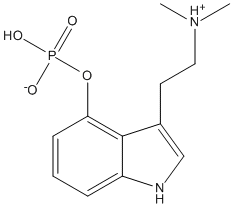Psilocybin
The indole alkaloid psilocybin and its dephosphorylated analogue psilocin are ingredients of Teonanacatl, the sacred mushroom of Mexico and responsible for their hallucinogenic effect (it is a 5-HT(2A) agonist). Mild inhibition of cholinesterases is unrelated to the hallucinogenic effect
General
Type : Organophosphate,Natural,Alkaloid,Indole
Chemical_Nomenclature : [3-[2-(dimethylamino)ethyl]-1H-indol-4-yl] dihydrogen phosphate
Canonical SMILES : CN(C)CCC1=CNC2=C1C(=CC=C2)OP(=O)(O)O
InChI : InChI=1S\/C12H17N2O4P\/c1-14(2)7-6-9-8-13-10-4-3-5-11(12(9)10)18-19(15,16)17\/h3-5,8,13H,6-7H2,1-2H3,(H2,15,16,17)
InChIKey : QVDSEJDULKLHCG-UHFFFAOYSA-N
Other name(s) : Psilocybine,Psilocibin,Indocybin,Psilotsibin,Teonanacatl
MW : 284.25
Formula : C12H17N2O4P
CAS_number : 520-52-5
PubChem : 10624
UniChem : QVDSEJDULKLHCG-UHFFFAOYSA-N
IUPHAR :
Wikipedia : Psilocybin

Target
References (4)
| Title : Acute psychological and physiological effects of psilocybin in healthy humans: a double-blind, placebo-controlled dose-effect study - Hasler_2004_Psychopharmacology.(Berl)_172_145 |
| Author(s) : Hasler F , Grimberg U , Benz MA , Huber T , Vollenweider FX |
| Ref : Psychopharmacology (Berl) , 172 :145 , 2004 |
| Abstract : Hasler_2004_Psychopharmacology.(Berl)_172_145 |
| ESTHER : Hasler_2004_Psychopharmacology.(Berl)_172_145 |
| PubMedSearch : Hasler_2004_Psychopharmacology.(Berl)_172_145 |
| PubMedID: 14615876 |
| Title : Hallucinogens - Nichols_2004_Pharmacol.Ther_101_131 |
| Author(s) : Nichols DE |
| Ref : Pharmacol Ther , 101 :131 , 2004 |
| Abstract : Nichols_2004_Pharmacol.Ther_101_131 |
| ESTHER : Nichols_2004_Pharmacol.Ther_101_131 |
| PubMedSearch : Nichols_2004_Pharmacol.Ther_101_131 |
| PubMedID: 14761703 |
| Title : The in vitro inhibitory effect of psilocybin and related compounds on human cholinesterases - |
| Author(s) : Zsigmond EK , Folddes VM , Foldes FF |
| Ref : Psychopharmacologia , 4 :232 , 1963 |
| PubMedID: |